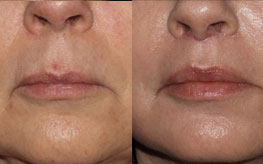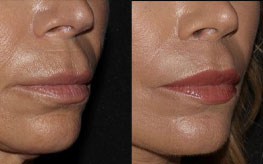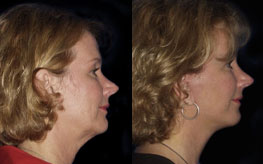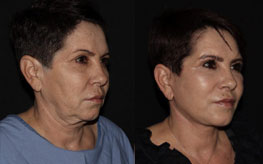Otoplasty (Ear Reshaping)
Conveniently located to serve the areas of San Diego, CA

An otoplasty is a procedure that reforms the shape, proportion, and/or positioning of the outer ears. Ear deformities as a result of genetics or an injury can be a major source of self-consciousness, but otoplasty techniques can create precise, natural-looking results that last a lifetime. Since the ears fully develop early, even children can undergo this minimally invasive surgery. An otoplasty often requires an incision in the back of each ear, allowing the surgeon to reshape and suture the internal cartilage. Along with other procedures, such as rhinoplasty or a facelift, cosmetic ear surgery brings balance and proportion to the ears and face. Even the correction of minor deformities can have profound benefits to appearance and self-esteem.
Specifically, otoplasty can resolve:
- Protruding ears occurring on one or both sides in varying degrees
- Overly large ears
- Dissatisfaction with previous ear surgery
- Long or stretched-out earlobes
- Torn earlobes
For more information about our ear reshaping procedure, please contact Alexander Cosmetic Surgery in San Diego online or call us at (888) 463-9532. We look forward to helping you look your best.
Contents
Understanding the Ear Reshaping Procedure

Individuals often try to hide prominent ears by wearing longer hair, but this can be a problem for those with shorter hair or when hair is wet while swimming. Prominent ears have a distinct look since they project from the scalp and have a more forward-facing appearance. There are also several anatomical differences in these types of ears; the upper part of the ear (the antihelical fold) is flattened and smooth because the normal, Y-shaped fold of the upper ear is missing. Sometimes, the ears may have a larger concha (the deep bowl of the ear) or be larger overall. (1)Another common deformity is the constriction of the helix in which the outer fold excessively overlaps the upper portion of the ear. Some patients are self-conscious about their ears even if they do not protrude because they may appear too large in relation to the face. In some cases, the earlobes are the main concern for patients. Often, earlobes become longer with age from heavy earrings and earring tears, leaving them unsightly.
At Alexander Cosmetic Surgery, our board-certified surgeons Dr. John T. Alexander II and Dr. Jordan Kaplan perform ear reshaping procedures regularly. Patients are pleased to fix this highly-visible problem and enjoy a significant increase in their self-esteem after this procedure. Dr. Alexander’s father invented a surgical instrument to reshape ear cartilage that is widely used by nearly all surgeons performing this procedure. As part of his father’s legacy, Dr. Alexander performs a successful and innovative technique to reduce the appearance of large, prominent ears in a way that is essentially scar-free. Problems related to the earlobe, such as size and tears, are easily fixable in minutes with only a local anesthetic.
Who is a Good Candidate?
Children who are good candidates for ear surgery are:
- Healthy, without a life-threatening illness or untreated chronic ear infections
- Generally 5 years old– when a child’s ear cartilage is stable enough for correction. (2)
- Cooperative and follow instructions well
- Able to communicate their feelings and do not voice any objections to the surgery
Teenagers and adults who are good candidates for ear surgery are:
- Healthy individuals who do not have medical conditions that can impair healing
- Non-smokers or willing to quit for a few weeks during preparation and recovery
- Individuals with a positive outlook and specific goals in mind for ear surgery
Because every case is unique, the only way to accurately determine which procedure is best is by scheduling a consultation our surgeons.
Personal Consultation
During your consultation with Dr. Alexander or Dr. Kaplan, they will have a full discussion with you about your concerns and ensure that you feel confident and comfortable with your decision. To promote the best results, they will recommend a procedure that aligns with your unique needs and desire for quality outcomes. They will conduct a series of examinations to determine a customized plan, promoting a result that harmonizes with your facial features. Our doctors will never follow a “one-size-fits-all” philosophy that does not give you the full scope of the options available to you. They will evaluate your candidacy and discuss:
- Why you want the surgery and your specific expectations
- Your medical conditions and any drug allergies
- Your current medications, supplements, alcohol, and tobacco usage
- Your previous surgeries, if applicable
Your surgeon may also:
- Measure the current proportions of your ears
- Take photographs of your ears for reference
- Discuss your options for anesthesia
Preparation
Before surgery, the doctors may advise you to:
- Take certain medications or adjust your current medications
- Avoid taking aspirin, anti-inflammatory drugs, and herbal supplements as they can increase bleeding
- Stop smoking well in advance of surgery
During a preoperative appointment, usually 1 to 2 weeks before surgery, we will:
- Get lab testing and/or a medical evaluation
- Tell you what to do on the night before and morning of surgery
- Discuss the use of anesthesia during your procedure
- Explain post-operative care, follow-up, and what kind of help you will need after the procedure
Finally, be sure to make plans with a trusted family member or friend to escort you to and from your surgery appointment. They should stay with you for the first 24 hours after your procedure.
Procedure Steps
To begin, our board-certified anesthesiologists will administer either intravenous sedation or general anesthesia. The method of anesthesia will depend on your preferences and the overall complexity of the procedure. They will discuss the details of this aspect of the procedure during your consultation.
The correction of prominent or constricted ears requires surgical techniques to create a natural-looking antihelical fold (the area within the upper rim of the ear) and reduce an enlarged concha (the largest bowl of the outer ear). The procedure typically takes 90-120 minutes to complete, depending on various surgical variables. These are some of the steps:
- Marking: The doctor will take measurements and make careful marks on your ears before beginning the procedure.
- The incision: They will likely make an incision on the back of each ear, but a front incision following the natural creases of the ear may be necessary.
- Reduction of conchal cartilage: They remove a small portion of cartilage from the back incision and secure the area with permanent sutures.
- Recreating the antihelical fold: They reshape the antihelical fold to create the Y-shape within the upper ear and secure it with non-removable sutures.
- Closing the incisions: They will place external sutures behind the ear and place a light, compressive dressing around the ears to protect them and decrease swelling and bruising
Otoplasty Recovery
Pain after an otoplasty is usually minimal, and our doctors will give you prescription medication to help you recover for the first couple of days. You should be able to switch to over-the-counter medication if you need relief past the first couple of days. If you have significant pain, it may signal a complication, so let us know if you experience this.
The post-surgical bandage will keep the surgical site clean, protect it from injury, and support the position of the ears for the first 3 days. You may experience some itchiness, but it is essential that you do not remove the bandages until your surgeon says otherwise. We will give you more specific instructions related to:
- Caring for the surgical sites
- Oral medications to aid healing and help prevent infection
- How to spot any signs of a complication or infection
- When you can return to work and exercising
Our doctors will see you the day after surgery, and will remove your bandages on the 3rd day. You should bring a snug headband with you. You will wear this headband 24/7 for the first week. For the next 4 weeks, you will only have to wear it at night to protect the ears. We will not have to remove any sutures since they are dissolvable. After this first week of healing, you will be able to resume normal activities. After 2 weeks, it will be safe to begin light exercise, and at 4 weeks, you will not have any restrictions.
You should follow the instructions on medication usage and other recovery measures to promote the most comfortable, quick recovery possible. You may want to consult them regarding herbal medications available to reduce swelling and bruising. It is vital that you do not subject the incisions to abrasion or force during the healing period, so you should avoid wearing tops that must go over the head.
Results
Once they remove all of the supportive dressings, you will notice the improved contours and positioning of the ears. With the ears more closely adhered to the head, any surgical scarring will be hidden behind the outer ears or within the natural folds of the ears. You may notice that the skin in the back of your ears seems swollen, but this is a normal part of the recovery and will resolve with time. About one week post-procedure, your ears will begin to look better, and within 3 months, they will return to normal.
Cost of Ear Surgery in San Diego
We will provide you with a quote after your consultation. Cost is always a consideration in elective surgery, but we offer a few different financing plans with CareCredit, so be sure to ask and consider applying. Costs include:
- Medical tests
- Surgeon’s fee
- Anesthesia fees
- Medication
- Operating room and supplies
- Post-surgery garments
Most insurance plans do not cover elective surgeries like the otoplasty or any possible complications.
To begin feeling more confident in the appearance of your ears, get in touch with Alexander Cosmetic Surgery using our contact form or call our San Diego office at (888) 463-9532.
References
- Driessen JP, Johannes Borgstein, Vuyk HD. Defining the Protruding Ear. Journal of Craniofacial Surgery. 2011;22(6):2102-2108. doi:https://doi.org/10.1097/scs.0b013e3182326dfb
- Naumann A. Otoplasty – techniques, characteristics and risks. GMS Current Topics in Otorhinolaryngology, Head and Neck Surgery. 2008;6:Doc04. Accessed June 24, 2024. https://www.ncbi.nlm.nih.gov/pmc/articles/PMC3199845/#:~:text=In%20the%20light%20of%20these





